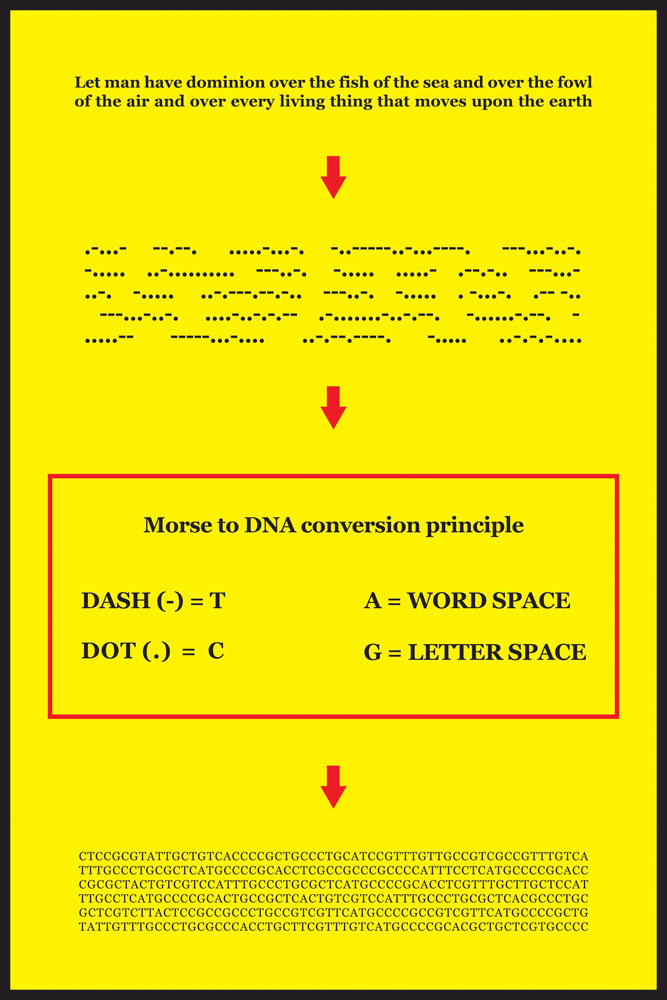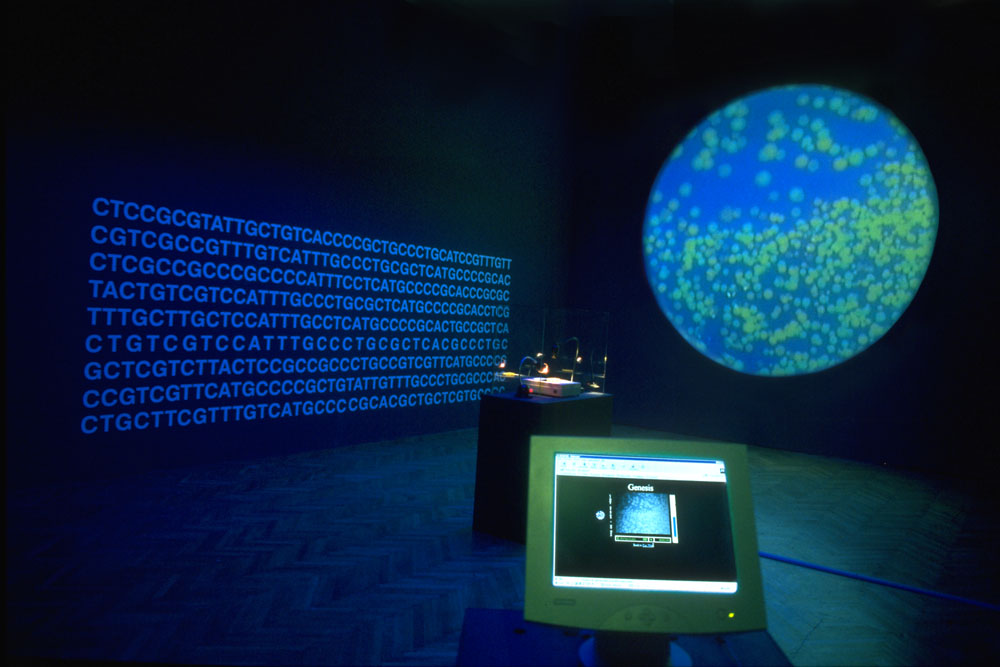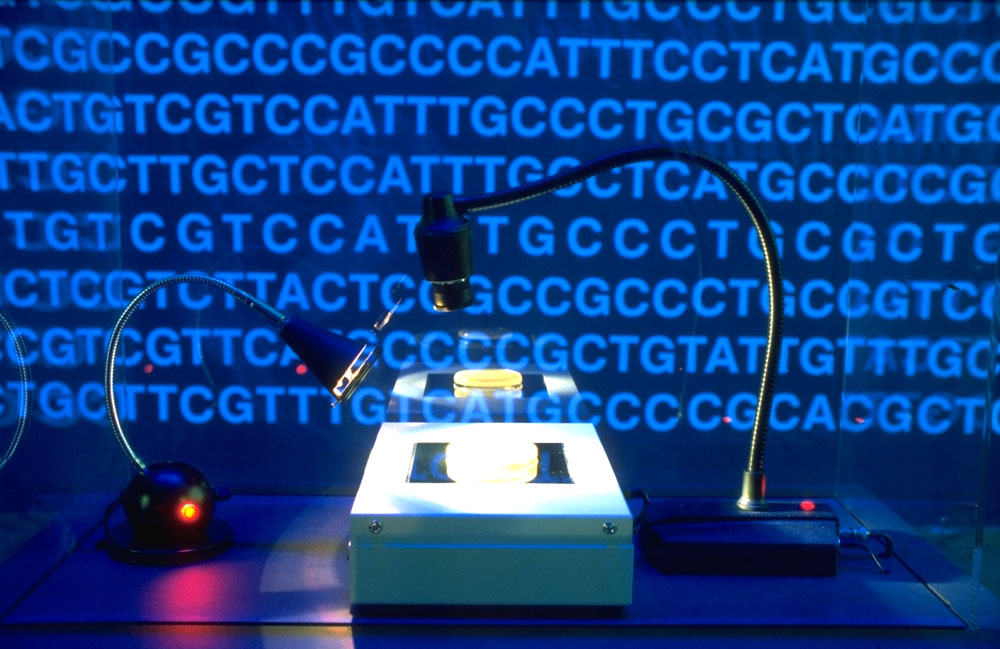Genesis
1999
Genesis (1998/99) is a transgenic artwork that explores the intricate relationship between biology, belief systems, information technology, dialogical interaction, ethics, and the Internet. The key element of the work is an "artist's gene", i.e., a synthetic gene that I invented and that does not exist in nature. This gene was created by translating a sentence from the biblical book of Genesis into Morse Code, and converting the Morse Code into DNA base pairs according to a conversion principle specially developed for this work. The sentence reads: "Let man have dominion over the fish of the sea, and over the fowl of the air, and over every living thing that moves upon the earth." This sentence was chosen for its implications regarding the dubious notion of (divinely sanctioned) humanity's supremacy over nature. Morse Code was chosen because, as first employed in radiotelegraphy, it represents the dawn of the information age -- the genesis of global communications.


The initial process in this work is the cloning of the synthetic gene into plasmids and their subsequent transformation into bacteria. A new protein molecule is produced by the gene. Two kinds of bacteria are employed in the work: bacteria that have incorporated a plasmid containing ECFP (Enhanced Cyan Fluorescent Protein) and bacteria that have incorporated a plasmid containing EYFP (Enhanced Yellow Fluorescent Protein). ECFP and EYFP are GFP (Green Fluorescent Protein) mutants with altered spectral properties. The ECFP bacteria contain the synthetic gene, while the EYFP bacteria do not. These fluorescent bacteria emit cyan and yellow light when exposed to UV radiation (302 nm). As they grow in number mutations naturally occur in the plasmids. As they make contact with each other plasmid conjugal transfer takes place and we start to see color combinations, possibly giving rise to green bacteria. Transgenic bacterial communication evolves as a combination of three visible scenarios: 1 - ECFP bacteria donate their plasmid to EYFP bacteria (and vice-versa), generating green bacteria; 2 - No donation takes place (individual colors are preserved); 3 - Bacteria loose their plasmid altogether (become pale, ochre colored).

The gallery display enables local as well as remote (Web) participants to monitor the evolution of the work. Remote participants on the Web interfere with the process by turning the UV light on. The energy impact of the UV light on the bacteria is such that it disrupts the DNA sequence in the plasmid, accelerating the mutation rate. The left and right walls contain large-scale texts applied directly on the wall: the sentence extracted from the book of Genesis (right) and the Genesis gene (left). Another picture of the gallery display here.
The strain of bacteria employed in Genesis is JM101. Normal mutation in this strain occurs 1 in 10^6 base pairs. Along the mutation process, the precise information originally encoded in the ECFP bacteria is altered. The mutation of the synthetic gene will occur as a result of three factors: 1) the natural bacterial multiplication process; 2) bacterial dialogical interaction; 3) human-activated UV radiation. The selected bacteria are safe to use in public and are displayed in the gallery with the UV source in a protective transparent enclosure.

The gallery display enables local as well as remote (Web) participants to monitor the evolution of the work. This display consists of a Petri dish with the bacteria, a flexible microvideo camera, a UV light box, and a microscope illuminator. This set is connected to a video projector and two networked computers. One computer works as a Web server (streaming live video and audio) and handles remote requests for UV activation. The other computer is responsible for DNA music synthesis. The local video projection shows a larger-than-life image of the bacterial division and interaction seen through the microvideo camera. Remote participants on the Web interfere with the process by turning the UV light on. The fluorescent protein in the bacteria responds to the UV light by emmiting visible light (cyan and yellow). The energy impact of the UV light on the bacteria is such that it disrupts the DNA sequence in the plasmid, accelerating the mutation rate. The left and right walls contain large-scale texts applied directly on the wall: the sentence extracted from the book of Genesis (right) and the Genesis gene (left).

In the context of the work, the ability to change the sentence is a symbolic gesture: it means that we do not accept its meaning in the form we inherited it, and that new meanings emerge as we seek to change it.
In the nineteenth century the comparison made by Champollion based on the three languages of the Rosetta Stone (Greek, demotic script, hierogliphs) was the key to understanding the past. Today the triple system of Genesis (natural language, DNA code, binary logic) is the key to understanding the future. "Genesis" explores the notion that biological processes are now writerly and programmable, as well as capable of storing and processing data in ways not unlike digital computers. Further investigating this notion, at the end of the show the altered biblical sentence is decoded and read back in plain English, offering insights into the process of transgenic interbacterial communication. The boundaries between carbon-based life and digital data are becoming as fragile as a cell membrane.
Genesis has original DNA-synthesized music by composer Peter Gena. The music is generated live in the gallery and streamed on the Web. The parameters of this multi-channel composition are derived from bacterial multiplication and mutation algorithms.
Genesis would not be possible without the expertise, support, and generosity of Dr. Charles Strom, Director of Medical Genetics, Illinois Masonic Medical Center.
Kac's article on "Genesis" (above) was first published in English and German in the catalogue of Genesis, O.K. Center for Contemporary Art, Linz, 1999, pp. 45-55. Also published in English and German in: Gerfried Stocker and Christine Schopf (eds.), Ars Electronica 99 - Life Science (Vienna, New York: Springer, 1999), pp. 310-313. Republished in French in Cahiers du CIRCAV, N. 12, Lille, France, 2000 (forthcoming). Republished in Spanish in Mediapolis, Buenos Aires, 2000. Republished in English in: Ascott, Roy (ed.). Art, Technology, Consciousness: Mind @ Large (Bristol : Intellect, 2000), pp.17-19.